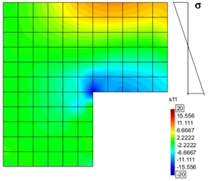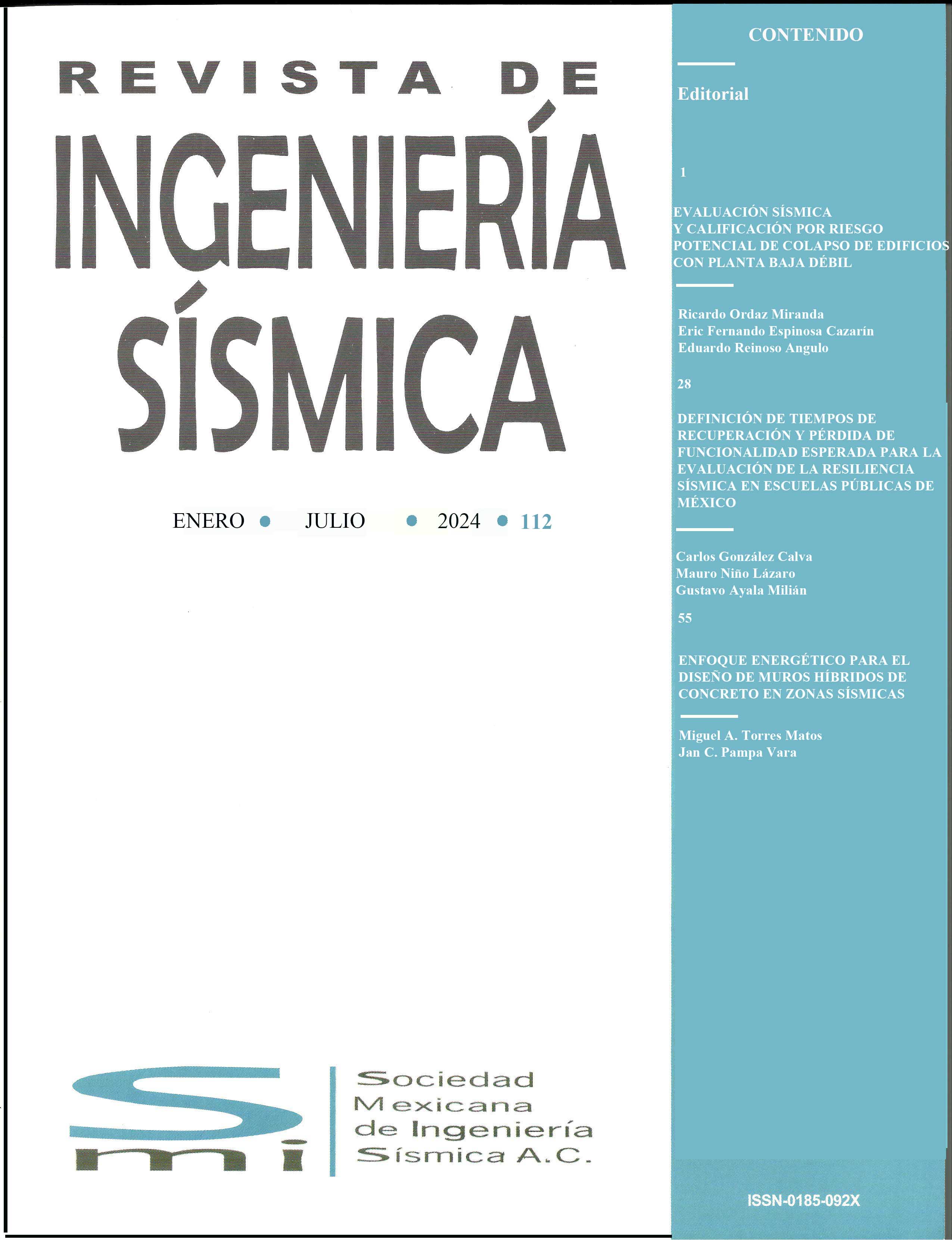APLICACIÓN DE LA SIMULACIÓN HÍBRIDA EN EL ANÁLISIS MULTI-ESCALA DE MARCOS
DOI:
https://doi.org/10.18867/ris.114.691Palabras clave:
simulación híbrida, Análisis no lineal, problemas multi-escala, marcos de aceroResumen
Este artículo presenta un procedimiento general de análisis de marcos en dos escalas aprovechando conceptos de simulación híbrida. La propuesta contempla el acoplamiento y transición entre elementos de distintas escalas, reduciendo la cantidad de grados de libertad en un modelo global y reproduciendo comportamientos complejos en modelos locales. Para gestionar la interacción de los modelos locales, se propone el uso de la plataforma de simulación híbrida, OpenFresco, distribuyendo el trabajo de cómputo y permitiendo la interacción con pruebas experimentales y modelos numéricos en distintos programas. La metodología se ilustra a través de la solución de un sistema elástico-lineal ante cargas gravitacionales y sísmicas, se compara el comportamiento y tiempos de análisis de modelos simplificados, modelos de elementos finitos y los del método propuesto. Finalmente, para evaluar y validar la metodología, se presenta el análisis de empuje lateral (pushover) de un marco de acero, obteniendo su curva de capacidad y mostrando la tendencia del método en dos escalas a los resultados de un modelo refinado de elementos finitos no-lineales, pero con una mayor eficiencia computacional.
Descargas
Citas
Garusi, E. y Tralli, A. (2002). “A hybrid stress-assumed transition element for solid-to-beam and plate-to-beam connections”. Computers & Structures, Vol 80, No 2, pp. 105–115. DOI: 10.1016/S0045-7949(01)00172-9
Huang, X., y Kwon, O. (2020). "A generalized numerical/experimental distributed simulation framework”. Journal of Earthquake Engineering, Vol. 24, No 4, pp. 682-703. DOI: 10.1080/13632469.2018.1423585
Huang, Y., Schellenberg, A., Mahin, S., y Fenves, G. (2008), “Coupling FE software through adapter elements: A novel use of user defined elements”, 10th International LS-DYNA Users Conference, Detroit, MI, Estados Unidos.
Kanber B. y Bozkurt O. (2006). “Finite element analysis of elasto-plastic plate bending problems using transition rectangular plate elements”. Acta Mechanica Sinica, Vol. 22, pp. 355-365. DOI: 10.1007/s10409-006-0012-y
Kwon, O-S., Nakata, N., Elnashai, A.S. y Spencer, B.F (2005). “A Framework for Multi-site Distributed Simulation and Application to Complex Structural Systems”. Journal of Earthquake Engineering, Vol. 9, No 5, pp. 741-753. DOI: 10.1080/13632460509350564
Li, Z., Chan, T. H., Yu, Y. y Sun, Z. (2009). “Concurrent multi-scale modeling of civil infrastructures for analyses on structural deterioration—part I: Modeling methodology and strategy”. Finite Elements in Analysis and Design, Vol. 45, No 11, pp. 782–794. DOI: 10.1016/j.finel.2009.06.013
Maekawa, K., Ishida, T. y Kishi, T. (2009). Multi-scale Modeling of Structural Concrete. Primera ed. Taylor & Francis. DOI: 10.1201/9781482288599
McKenna, F., Fenves, G. y Scott M. (2000), Open System for Earthquake Engineering Simulation, University of California, Berkeley CA. Estados Unidos. http://opensees.berkeley.edu
Mourlas, C., Gravett, D. Z., Markou, G., y Papadrakakis, M. (2019). “Investigation of the soil structure interaction effect on the dynamic behavior of multistorey RC buildings”. VIII international conference on computational methods for coupled problems in science and engineering, Coupled Problems CIMNE, Barcelona, España.
Paniagua, C. y Ayala, A.G. (2023), “Two scale seismic analysis of masonry infill concrete frames through hybrid simulation”. Earthquakes and Structures, Vol. 24, No 6, pp 393-404. DOI: 10.12989/eas.2023.24.6.393
Park, J., Strepelias, E., Stathas, N., Kwon, O. S., y Bousias, S. (2021). “Application of hybrid simulation method for seismic performance evaluation of RC coupling beams subjected to realistic boundary condition. Earthquake Engineering & Structural Dynamics, Vol. 50, No 2, pp. 375-393. DOI: 10.1002/eqe.3335
Pegon, P. y Pinto, A.V. (2000). “Pseudo-dynamic testing with substructuring at the ELSA Laboratory”. Earthquake engineering & structural dynamics, Vol. 29, pp. 905-925. DOI: 10.1002/1096-9845(200007)29:7%3C905::AID-EQE941%3E3.0.CO;2-P
Poliotti, M., Bairán, J.-M., y Möller, O. (2021). “A variable order framework for 3d nonlinear analysis of reinforced concrete frames under general loading”. Engineering Structures, Vol. 242, No 112536. DOI: 10.1016/j.engstruct.2021.112536
Przemieniecki, J. S. (1985). Theory of Matrix Structural Analysis. Primera ed. Dover Publications
Schellenberg, A. H. (2009), “Advanced implementation of hybrid simulation”, PEER Reporte 2009/104 Earthquake Engineering Research Center, University of California, Berkeley, CA, Estados Unidos. https://peer.berkeley.edu/publications/2009-104
Schellenberg, A., Mahin, S. A. y Fenves, G. L. (2006), “Application of an experimental software framework for international hybrid simulation”, 4th International Conference on Earthquake Engineering, Taipei, Taiwan.
Schellenberg, A., Mahin, S. A. y Fenves, G. L. (2007), “A software framework for hybrid simulation of large structural systems”, ASCE Structural Engineering Research Frontiers Congress, Reston, VA, Estados Unidos.
Takahashi, Y. y Fenves, G. L. (2006). “Software framework for distributed experimental–computational simulation of structural systems”. Earthquake engineering & structural dynamics, Vol. 35, No 3, pp. 267-291. DOI: 10.1002/eqe.518
Takeda, T., Sozen, M. A. y Nielsen, N. N. (1970). “Reinforced concrete response to simulated earthquakes”. Journal of the structural division, Vol. 96, No 12, pp. 2557–2573. DOI: 10.1061/JSDEAG.0002765
Taucer, F., Spacone, E. y Filippou, F. C. (1991). “A fiber beam-column element for seismic response analysis of reinforced concrete structures”, Reporte UCB/EERC-91/17. Earthquake Engineering Research Center, University of California, Berkeley, CA, Estados Unidos. https://nisee.berkeley.edu/elibrary/Text/237794
Wang, F., Xu, Y. y Qu, W. (2014). “Mixed-dimensional finite element coupling for structural multi-scale simulation”. Finite Elements in Analysis and Design, Vol. 92, pp. 12–25. DOI: 10.1016/j.finel.2014.07.009
Weinan, E. (2011), Principles of Multiscale Modeling. Primera ed. Cambridge University Press. https://assets.cambridge.org/97811070/96547/frontmatter/9781107096547_frontmatter.pdf
Yue, J. G., Fafitis, A., Qian, J., y Lei, T. (2011), “Application of 1D/3D finite elements coupling for structural nonlinear analysis”, Journal of Central South University of Technology, Vol. 18, No 3, pp. 889-897. DOI: 10.1007/s11771-011-0778-3

Descargas
Publicado
Cómo citar
Número
Sección
Licencia
Derechos de autor 2025 Revista Ingeniería Sísmica

Esta obra está bajo una licencia internacional Creative Commons Atribución-NoComercial 4.0.






